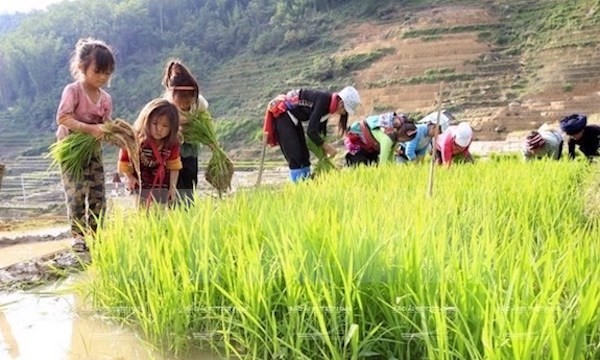 Society
Society

The National Programme on Preventing and Reducing Child Labour for the years 2016-2020 aims to end child labour exploitation. All 100 per cent of the child labourers will be assisted to integrate into the community and get the chance to grow, Đào Hồng Lan, Deputy Minister of Labour, Invalids and Social Affairs said.
 |
| Most Vietnamese child labourers work in the agriculture sector. — VNA/VNS Photo |
HÀ NỘI — The National Programme on Preventing and Reducing Child Labour for the years 2016-2020 aims to end child labour exploitation. All 100 per cent of the child labourers will be assisted to integrate into the community and get the chance to grow, Đào Hồng Lan, Deputy Minister of Labour, Invalids and Social Affairs said.
“The programme has concrete measures by the Vietnamese government, which has committed to international pledges to reach Sustainable Development Goals on child labour,” she said.
The information was released at a workshop on development of the guidelines for the programme’s implementation hosted by the Ministry of Labour, Invalids and Social Affairs (MOLISA) on Thursday.
Lan said the programme would offer training to children on survival and self-protection skills, help families that have children working illegally and support employers in improving working conditions and creating jobs in line with children’s ages.
The latest statistics from MOLISA showed that nationwide there are more than 1.75 million children doing hard labour or working in an unhealthy environment. Child labourers were also present in the large cities, including Hà Nội and HCM City.
Some 67 per cent of the children work in the agriculture sector, 16.6 per cent work for services and 15.8 per cent work in the industry-construction sector.
Đặng Hoa Nam, director of the ministry’s Child Care and Protection Department, said majority of the child labourers below 15 years old work in the agriculture sector. From 15 to 17 years old, they move to work at industrial parks and construction sites.
“What remains sad is the number of children out of school is still very high. Among child workers surveyed, up to 52 per cent used to go to school; 45.2 per cent are going to school and 2.8 per cent do not know what school is,” he said.
He said the main difficulty is limited family awareness. Many parents think child labour is not banned but is just a way to share housework within families
According to participants, wages for child labourers remain very low, even though the children have to work in unfavourable conditions and suffer from serious labour exploitation.
Children are forced to work 11-12 hours a day, going up to even 16 hours. Many are not paid wages.
Participants agree that Việt Nam faces challenges, for example, families of child labourers, children and employers lack knowledge about child labour policies. Limited access to skill and occupation developing activities is also a hindrance to child labour elimination efforts.
The National Programme on Preventing and Reducing Child Labour during 2016-2020 period was adopted by Prime Minister Nguyễn Xuân Phúc in June this year.
Over the past years, the government has made efforts in reducing child labour. Its most remarkable achievement is to be the first Asian country and the second country in the world to justify the UN Convention on the Rights of the Child. Việt Nam also approved International Labour Organisation’s Convention on the Worst Forms of Child Labour. — VNS




.jpg)